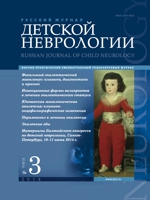CLINICAL AND ELECTROENCEPHALOGRAPHIC CHANGES IN JUVENILE MYOCLONIC EPILEPSY (A LECTURE)
- Authors: Mukhin K.Y.1, Mironov M.B.1, Glukhova L.Y.1
-
Affiliations:
- Svt. Luka’s Institute of Child Neurology and Epilepsy, Moscow
- Issue: Vol 9, No 3 (2014)
- Pages: 30-35
- Section: REVIEWS AND LECTURES
- Published: 18.04.2015
- URL: https://rjdn.abvpress.ru/jour/article/view/28
- DOI: https://doi.org/10.17650/2073-8803-2014-9-3-30-35
- ID: 28
Cite item
Full Text
Abstract
Juvenile myoclonic epilepsy (JME) is a form of idiopathic generalized epilepsy characterized by adolescent onset with massive myoclonic
seizures and, in most cases, convulsive seizures occurring mainly on awakening. According to the Proposed Diagnostic Schema for People
with Epileptic Seizures and with Epilepsy (2001), JME is classified into a group of idiopathic generalized epilepsy with a variable phenotype. The authors give the genetic bases of the disease, describe its clinical picture in detail, including the atypical course of JME, and consider diagnostic criteria, approaches to patient management, and principles of medical therapy. By taking into account the most common precipitating factors, along with drug therapy, the sleep and wake regimen must be strictly adhered to and household photo stimulation be avoided. Complete medical remission is achieved in about 90 % of patients (on correctly chosen therapy), in most cases on monotherapy. However, the problem resides in high recurrence rates after withdrawal of antiepileptic drugs. The major predictors of increased risk for a recurrence after
therapy discontinuation are considered.
About the authors
K. Yu. Mukhin
Svt. Luka’s Institute of Child Neurology and Epilepsy, Moscow
Author for correspondence.
Email: center@epileptologist.ru
Russian Federation
M. B. Mironov
Svt. Luka’s Institute of Child Neurology and Epilepsy, Moscow
Email: fake@neicon.ru
Russian Federation
L. Yu. Glukhova
Svt. Luka’s Institute of Child Neurology and Epilepsy, Moscow
Email: fake@neicon.ru
Russian Federation
References
Supplementary files






